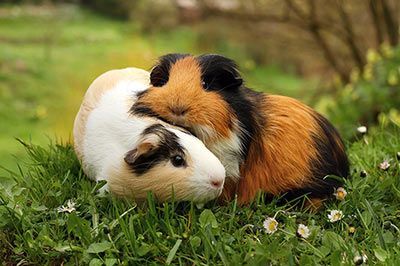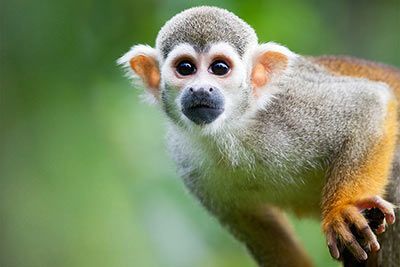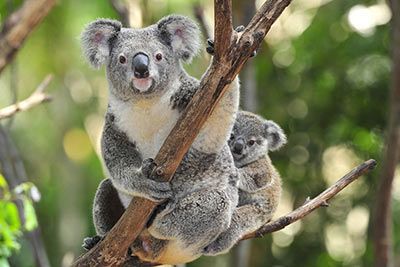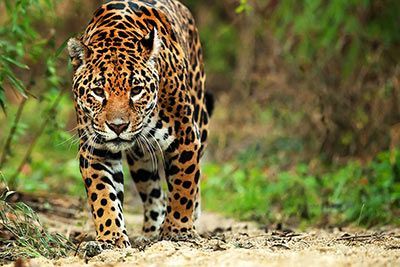Asian Rhinoceros
Asian Rhinoceros Facts
| Size | Up to 5 feet (180 cm) (shoulder height) |
| Speed | Up to 31 mph (50 km/h) |
| Weight | 1,100-4,850 pounds (500-2,200 kg) |
| Lifespan | 35-50 years |
| Food | Plants |
| Predators | - |
| Habitat | Indonesia, India |
| Order | Odd-toed ungulates |
| Family | Rhinocerosses |
| Scientific name | Rhinoceros unicornis (Indian), Rhinoceros sondaicus (Javan), Dicerorhinus sumatrensis (Sumatran) |
| Characteristics | 1-2 horns on the nose, massive body, short legs |
Main Characteristics
There are three species of rhinoceros in Asia: the Sumatran rhinoceros, Javan rhinoceros and Indian rhinoceros. All three species are endangered or threatened with extinction. The reasons for this are poaching and loss of habitat.
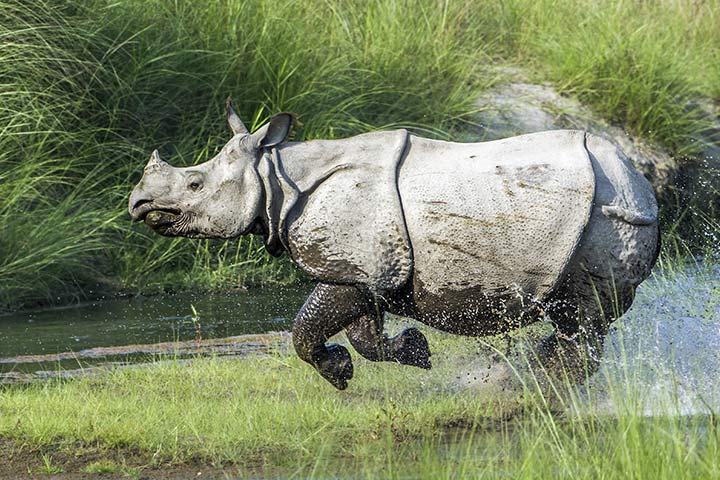
Distribution and Habitat
The Indian rhinoceros is widespread in India, Nepal and Bhutan. The Javan rhinoceros lives on the Indonesian island of Java and the Sumatran rhinoceros lives on the Indonesian island of Sumatra. Their habitat is tropical rain and mountain forests, grasslands and swamps.
Life Style
All Asian rhino species are most active during the night and at dusk. They tend to live solitary lives, particularly the male rhinos. The young calves remain with their mothers for approximately three years before they go their separate ways.
Species
• The Indian Rhino
The Indian rhinoceros is also known as “greater one-horned rhino”. It is closely related to the Javan rhinoceros, but lives in India instead of Indonesia. Both species have overlapping folds of skin that look like some kind of armor. These can be seen much more clearly in the Indian rhinoceros. The animals are very brave: They even attack elephants when they invade their territory.
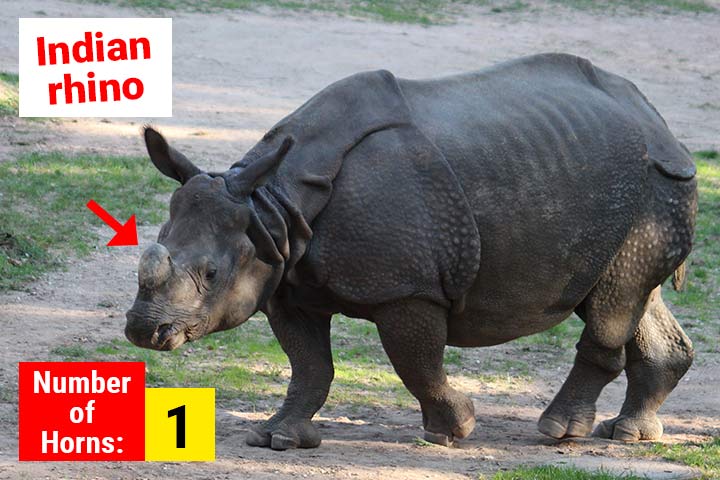
• The Javan Rhino
The Javan rhinoceros lives in Indonesia. Its habitat is dense, evergreen forests, streams and swampy areas. It loves to roll in the mud to cool down its body. The mud also protect it from insect bites because they can't get through the thick layer of mud. The rhino also likes to take a refreshing bath in the river, where hungry fish rid them of ticks and leeches.
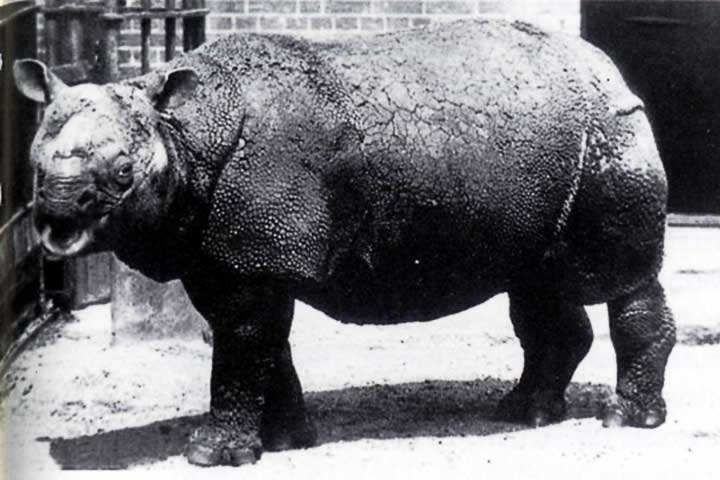
• The Sumatran Rhino
The Sumatran rhino lives in Indonesia and is the smallest of the three. It prefers hilly mountainous terrain and is a skilled climber on steep terrain.

Anatomy and Appearance
Size and Weight
• Indian Rhino
It measures 12 feet (368-380 cm) in body length, with a shoulder height ranging from 67-73 inches (170 to 186 cm). Its weight is 3,500-4,800 pounds (1,600-2,200 kg). It is said that there was an animal of extraordinary size that weighed 8,800 pounds (4,000 kg), but there is no official confirmation of this. The female rhinos are slightly smaller and lighter.
• Sumatran Rhino
The Sumatran rhino is the smallest of the three Asian rhino species. Its body length is 8-10 feet (250-320 cm) and its shoulder height is 47-55 inches (120-140 cm). It weighs 1,100-1,760 pounds (500-800 kg).
• Javan-Rhino
The Javan rhino is 10-11 feet (300-340 cm) in length. It has a shoulder height of 55-66 inches (140-170) cm. It weight is 1,980-3,970 pounds (900-1,800 kg).
Horns
The Asian rhino species have different numbers of horns. The Sumatran rhinoceros has two horns. The Indian rhinoceros and the Javan rhinoceros have one horn. In all Asian species the horn is rather short, especially compared to the African species. It only grows 4-6 inches (10-15 cm) long. In rare cases, the horn of the Indian rhinoceros can grow to be over 20 inches (50 cm) long and weigh 6-7 pounds (3 kg).
Fur
Rhinos don't have fur. Or do they? Actually, there is one species that has a kind of “fur”: the Sumatran rhinoceros. Contrary to the other species, it is hairy and has fine, reddish-brown hair all over its body. However, the adult animals usually lose their fur over time, so only the young animals have fur. Otherwise, no rhino has fur, except for some hair on their ears and the tip of their tail.
Diet
Asian rhinos are herbivores. They feed primarily on leaves, grass, twigs, but also fruits and seeds.
Behavior
Mud Bath
Asian rhinos spend a lot of time wallowing in mud. The mud layer protects them from insect bites and is also protection against the sun.
Abilities and Senses
Senses
Asian rhinos have poor eyesight and struggle to see clearly. However, their hearing and sense of smell are excellent.
Can Rhinos Swim?
The African ones can't, but the Asian ones can. Given their weight, this is quite amazing.
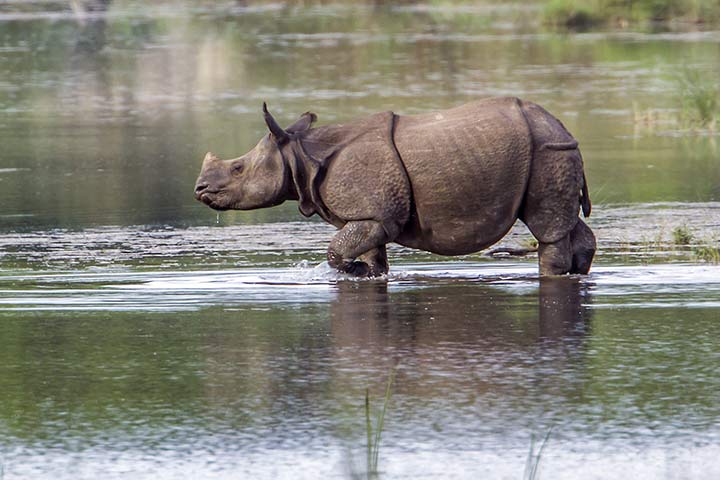
Life Expectancy
In the wild, Asian rhinos live to be 35-40 years old.
Enemies and Threats
Natural Enemies
Asian rhinos have no natural enemies ... anymore. Tigers used to be a threat to young, weak or sick individuals. However, there are hardly any tigers left in their habitat.
Poaching and Hunting
The biggest threat to Asian rhinos is humans. Poaching is responsible for the death of the majority of animals. Due to increasing deforestation, they're also loosing more and more habitat.
Why Do People Hunt Rhinos?
Unfortunately, the horn of the rhino is highly sought after. Some people believe that horn powder has great healing effects. It is said to cure fever seizures and rheumatism and helps to remove toxic substances from the body. In former times, the Romans drinking vessels were made from horn. The poeple were convinced that it could render poisonous drinks harmless (Romans often poisoned each other). However, the healing effect has never been scientifically proven.
Population and Protective Measures
• Indian Rhinoceros
How many Indian rhinos are left? According to the 2023 IUCN report, there are currently 4,013 Indian rhinos. It is very pleasing that the number of animals is increasing. Nevertheless, its status is “endangered”.
• Sumatran Rhinoceros
The Sumatran rhinoceros is critically endangered. A count by the IUCN in 2023 showed that there are only 76 Sumatran rhinos left. However, the number of animals is at least "stable" for now.
• Javan Rhinoceros
How many Javan rhinos are still alive? In 2023, only 34-47 Javan rhinos were counted by the IUCN. The population decreases every year. The animals are considered “critically endangered”.

Importance for the Ecosystem
Due to their weight and size, Asian rhinos have a major influence on the flora in their habitat. They trample the plants, creating popular feeding grounds for smaller herbivores. The rhinos also feed on fruits and spread their seeds through their droppings.
Reproduction
A newborn Indian rhinoceros baby weighs 130-165 pounds (60-75 kg) and is able to stand on its own legs after just 30 minutes. It is nursed for 1.5 years and is independent at the age of three. Very little is known about Javan and Sumatran rhinoceros reproduction. It probably takes 16-19 months for a single baby to be born. Until now, there have been no sightings of births in their natural habitat.
Fun Facts
Albrecht Dürer's Rhinoceros
The most famous picture of a rhinoceros comes from the German painter and graphic artist Albrecht Dürer. In 1515 he made a woodcut of an Indian rhinoceros. However, he had never seen such an animal himself. He made it based on stories and sketches.
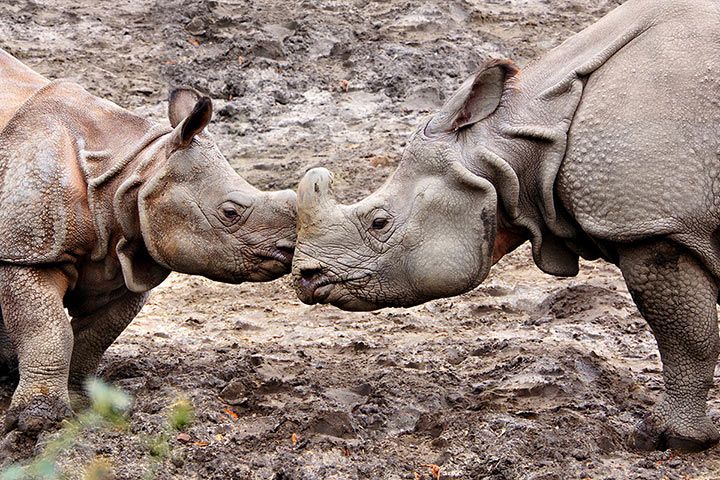
The Asian Rhinoceros Is Related To:
- African Rhinoceros
- Horse
- Tapir
Animals in the Same Biome:
Related Articles:














